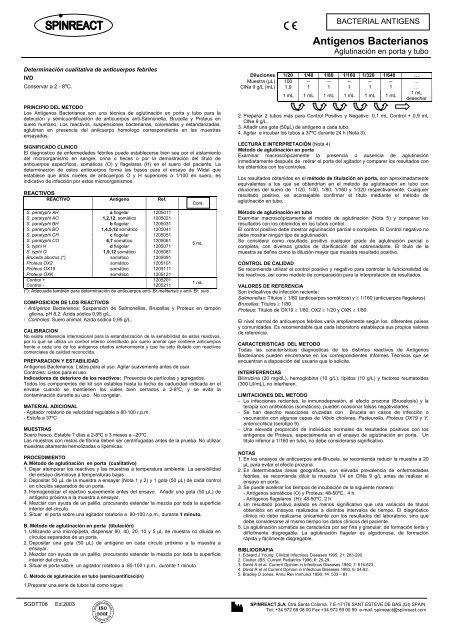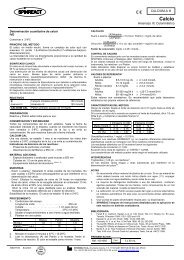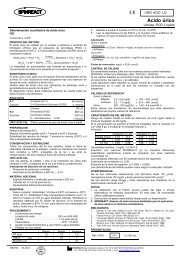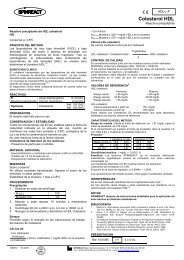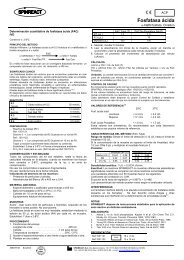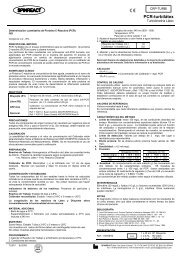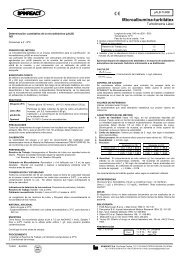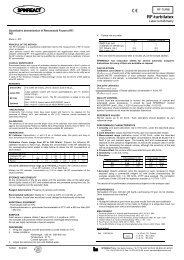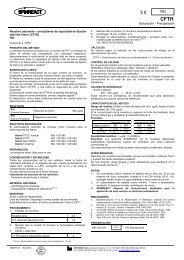Tecnicas Ingles-Español Turbilatex - IDCCA
Tecnicas Ingles-Español Turbilatex - IDCCA
Tecnicas Ingles-Español Turbilatex - IDCCA
Create successful ePaper yourself
Turn your PDF publications into a flip-book with our unique Google optimized e-Paper software.
Determinación cualitativa de anticuerpos febriles<br />
IVD<br />
Conservar a 2 - 8ºC.<br />
PRINCIPIO DEL METODO<br />
Los Antígenos Bacterianos son una técnica de aglutinación en porta y tubo para la<br />
detección y semicuantificación de anticuerpos anti-Salmonella, Brucella y Proteus en<br />
suero humano. Los reactivos, suspensiones bacterianas, coloreadas y estandarizadas,<br />
aglutinan en presencia del anticuerpo homologo correspondiente en las muestras<br />
ensayadas.<br />
SIGNIFICADO CLINICO<br />
El diagnostico de enfermedades febriles puede establecerse bien sea por el aislamiento<br />
del microorganismo en sangre, orina o heces o por la demostración del título de<br />
anticuerpos específicos, somáticos (O) y flagelares (H) en el suero del paciente. La<br />
determinación de estos anticuerpos forma las bases para el ensayo de Widal que<br />
establece que altos niveles de anticuerpos O y H superiores a 1/100 en suero, es<br />
indicativo de infección por estos microorganismos.<br />
REACTIVOS<br />
REACTIVO Antígeno Ref.<br />
S. paratyphi AH a flagelar 1205011<br />
S. paratyphi AO 1,2,12, somático 1205021<br />
S. paratyphi BH b flagelar 1205031<br />
S. paratyphi BO 1,4,5,12 somático 1205041<br />
S. paratyphi CH c flagelar 1205051<br />
S. paratyphi CO<br />
S. typhi H<br />
6,7 somático<br />
d flagelar<br />
1205061<br />
1205071<br />
5 mL<br />
S. typhi O 1,9,12 somático 1205081<br />
Brucella abortus (*) somático 1205091<br />
Proteus OX2 somático 1205101<br />
Proteus OX19 somático 1205111<br />
Proteus OXK somático 1205121<br />
Control +<br />
Control -<br />
1205201<br />
1205211<br />
1 mL<br />
(*): Adecuada también para determinación de anticuerpos anti- Br.melitensis y anti- Br. suis .<br />
COMPOSICION DE LOS REACTIVOS<br />
- Antígenos Bacterianos: Suspensión de Salmonellas, Brucellas y Proteus en tampón<br />
glicina, pH 8,2. Azida sódica 0,95 g/L.<br />
- Controles: Suero animal. Azida sódica 0,95 g/L.<br />
CALIBRACION<br />
No existe referencia internacional para la estandarización de la sensibilidad de estos reactivos,<br />
por lo que se utiliza un control interno constituido por suero animal que contiene anticuerpos<br />
frente a cada uno de los antígenos citados anteriormente y que ha sido titulado con reactivos<br />
comerciales de calidad reconocida.<br />
PREPARACION Y ESTABILIDAD<br />
Antígenos Bacterianos: Listos para el uso. Agitar suavemente antes de usar.<br />
Controles: Listos para el uso.<br />
Indicadores de deterioro de los reactivos: Presencia de partículas y agregados.<br />
Todos los componentes del kit son estables hasta la fecha de caducidad indicada en el<br />
envase cuando se mantienen los viales bien cerrados a 2-8ºC, y se evita la<br />
contaminación durante su uso. No congelar.<br />
MATERIAL ADICIONAL<br />
- Agitador rotatorio de velocidad regulable a 80-100 r.p.m.<br />
- Estufa a 37ºC<br />
MUESTRAS<br />
Suero fresco. Estable 7 días a 2-8ºC o 3 meses a –20ºC.<br />
Las muestras con restos de fibrina deben ser centrifugadas antes de la prueba. No utilizar<br />
muestras altamente hemolizadas o lipémicas.<br />
PROCEDIMIENTO<br />
A. Método de aglutinación en porta (cualitativo)<br />
1. Dejar atemperar los reactivos y las muestras a temperatura ambiente. La sensibilidad<br />
del ensayo disminuye a temperaturas bajas.<br />
2. Depositar 50 µL de la muestra a ensayar (Nota 1 y 2) y 1 gota (50 µL) de cada control<br />
en círculos separados de un porta.<br />
3. Homogeneizar el reactivo suavemente antes del ensayo. Añadir una gota (50 µL) de<br />
antígeno próxima a la muestra a ensayar.<br />
4. Mezclar con ayuda de un palillo, procurando extender la mezcla por toda la superficie<br />
interior del círculo.<br />
5. Situar el porta sobre una agitador rotatorio a 80-100 r.p.m., durante 1 minuto.<br />
B. Método de aglutinación en porta (titulación)<br />
1. Utilizando una micropipeta, dispensar 80, 40, 20, 10 y 5 µL de muestra no diluida en<br />
círculos separados de un porta.<br />
2. Depositar una gota (50 µL) de antígeno en cada círculo próximo a la muestra a<br />
ensayar.<br />
3. Mezclar con ayuda de un palillo, procurando extender la mezcla por toda la superficie<br />
interior del círculo.<br />
4. Situar el porta sobre un agitador rotatorio a 80-100 r.p.m., durante 1 minuto.<br />
C. Método de aglutinación en tubo (semicuantificación)<br />
1.Preparar una serie de tubos tal como sigue:<br />
Cont.<br />
BACTERIAL ANTIGENS<br />
Antígenos Bacterianos<br />
Aglutinación en porta y tubo<br />
Diluciones 1/20 1/40 1/80 1/160 1/320 1/640 …<br />
Muestra (µL) 100 -- -- -- -- -- …<br />
ClNa 9 g/L (mL) 1,9 1 1 1 1 1 …<br />
1 mL 1 mL 1 mL 1 mL 1 mL 1 mL<br />
1 mL<br />
desechar<br />
2. Preparar 2 tubos más para Control Positivo y Negativo: 0,1 mL Control + 0,9 mL<br />
ClNa 9 g/L.<br />
3. Añadir una gota (50µL) de antígeno a cada tubo.<br />
4. Agitar e incubar los tubos a 37ºC durante 24 h (Nota 3).<br />
LECTURA E INTERPRETACIÓN (Nota 4)<br />
Método de aglutinación en porta<br />
Examinar macroscópicamente la presencia o ausencia de aglutinación<br />
inmediatamente después de retirar el porta del agitador y comparar los resultados con<br />
los obtenidos con los controles.<br />
Los resultados obtenidos en el método de titulación en porta, son aproximadamente<br />
equivalentes a los que se obtendrían en el método de aglutinación en tubo con<br />
diluciones del suero de 1/20, 1/40, 1/80, 1/160 y 1/320 respectivamente. Cualquier<br />
resultado positivo, es aconsejable confirmar el título mediante el método de<br />
aglutinación en tubo.<br />
Método de aglutinación en tubo<br />
Examinar macroscópicamente el modelo de aglutinación (Nota 5) y comparar los<br />
resultados con los obtenidos en los tubos control.<br />
El control positivo debe mostrar aglutinación parcial o completa. El Control negativo no<br />
debe mostrar ningún tipo de aglutinación.<br />
Se considera como resultado positivo cualquier grado de aglutinación parcial o<br />
completa, con diversos grados de clarificación del sobrenadante. El título de la<br />
muestra se define como la dilución mayor que muestra resultado positivo.<br />
CONTROL DE CALIDAD<br />
Se recomienda utilizar el control positivo y negativo para controlar la funcionalidad de<br />
los reactivos, así como modelo de comparación para la interpretación de resultados.<br />
VALORES DE REFERENCIA<br />
Son indicativos de infección reciente:<br />
Salmonellas: Títulos ≥ 1/80 (anticuerpos somáticos) y ≥ 1/160 (anticuerpos flagelares).<br />
Brucellas: Títulos ≥ 1/80.<br />
Proteus: Títulos de OX19 ≥ 1/80, OX2 ≥ 1/20 y OXK ≥ 1/80.<br />
El nivel normal de anticuerpos febriles varia ampliamente según los diferentes países<br />
y comunidades. Es recomendable que cada laboratorio establezca sus propios valores<br />
de referencia.<br />
CARACTERISTICAS DEL METODO<br />
Todas las características diagnosticas de los distintos reactivos de Antígenos<br />
Bacterianos pueden encontrarse en los correspondientes Informes Técnicos que se<br />
encuentran a disposición del usuario que lo solicite.<br />
INTERFERENCIAS<br />
Bilirrubina (20 mg/dL), hemoglobina (10 g/L), lípidos (10 g/L) y factores reumatoides<br />
(300 UI/mL), no interfieren.<br />
LIMITACIONES DEL METODO<br />
- La infecciones recientes, la inmunodepresión, el efecto prozona (Brucelosis) y la<br />
terapia con antibióticos (somáticos), pueden ocasionar falsas negatividades.<br />
- Se han descrito reacciones cruzadas con Brucela en casos de infección o<br />
vacunación con algunas cepas de Vibrio cholerae, Pasteurella, Proteus OX19 y Y.<br />
enterocolitica (serotipo 9).<br />
- Una elevada proporción de individuos normales da resultados positivos con los<br />
antígenos de Proteus, especialmente en el ensayo de aglutinación en porta. Un<br />
título inferior a 1/160 en tubo, no debe considerarse significativo.<br />
NOTAS<br />
1. En los ensayos de anticuerpos anti-Brucela, se recomienda reducir la muestra a 20<br />
µL para evitar el efecto prozona.<br />
2. En determinadas áreas geográficas, con elevada prevalencia de enfermedades<br />
febriles, se recomienda diluir la muestra 1/4 en ClNa 9 g/L antes de realizar el<br />
ensayo en porta.<br />
3. Se puede acelerar los tiempos de incubación de la siguiente manera:<br />
- Antígenos somáticos (O) y Proteus: 48-50ºC, 4 h.<br />
- Antígenos flagelares (H): 48-50ºC, 2 h.<br />
4. Un resultado positivo aislado es menos significativo que una variación de títulos<br />
obtenidos en ensayos realizados a distintos intervalos de tiempo. El diagnóstico<br />
clínico no debe realizarse únicamente con los resultados del laboratorio, sino que<br />
debe considerarse al mismo tiempo los datos clínicos del paciente.<br />
5. La aglutinación somática se caracteriza por ser fina y granular, de formación lenta y<br />
difícilmente disgregable. La aglutinación flagelar es algodonosa, de formación<br />
rápida y fácilmente disgregable.<br />
BIBLIOGRAFIA<br />
1. Edward J Young. Clinical Infectious Diseases 1995; 21: 283-290.<br />
2. Coulter JBS. Current Pediatrics 1996; 6: 25-29.<br />
3. David A et al. Current Opinion in Infectious Diseases 1994; 7: 616-623.<br />
4. David R et al Current Opinion in Infectious Diseases 1993; 6: 54-62.<br />
5. Bradley D Jones. Annu Rev Immunol 1996; 14: 533 – 61.<br />
SGDTT06 Ed.2003 SPINREACT,S.A. Ctra.Santa Coloma, 7 E-17176 SANT ESTEVE DE BAS (GI) SPAIN<br />
Tel. +34 972 69 08 00 Fax +34 972 69 00 99 e-mail: spinreact@spinreact.com
Qualitative determination of febrile antibodies<br />
IVD<br />
Store at 2 - 8ºC.<br />
PRINCIPLE OF THE METHOD<br />
The Bacterial Antigens is a slide and tube agglutination test for the qualitative and semiquantitative<br />
detection of antibodies anti-Salmonella, Brucella and certain Rickettsias in<br />
human serum. The reagents, standardized suspensions of killed and stained bacteria,<br />
agglutinate when mixed with samples containing the homologous antibody.<br />
CLINICAL SIGNIFICANCE<br />
Febrile diseases diagnostic may be assessed either by microorganism isolation in blood,<br />
stools or urine, or by titration of specific antibodies, somatic (O) and flagellar (H). The<br />
detection of these antibodies forms the basis for the long-established Widal test. This test<br />
dictates that a serum with high levels of agglutinating antibodies to O and H >1/100 is<br />
indicative of the infection with these microorganism.<br />
REAGENTS<br />
REAGENT Antigen Ref.<br />
S. paratyphi AH a flagellar 1205011<br />
S. paratyphi AO 1,2,12, somatic 1205021<br />
S. paratyphi BH b flagellar 1205031<br />
S. paratyphi BO 1,4,5,12 somatic 1205041<br />
S. paratyphi CH c flagellar 1205051<br />
S. paratyphi CO 6,7 somatic 1205061 5 mL<br />
S. typhi H d flagellar 1205071<br />
S. typhi O 1,9,12 somatic 1205081<br />
Brucella abortus (*) somatic 1205091<br />
Proteus OX2 somatic 1205101<br />
Proteus OX19 somatic 1205111<br />
Proteus OXK somatic 1205121<br />
Control +<br />
Control -<br />
1205201<br />
1205211<br />
1 mL<br />
(*): Useful also for Brucella melitensis and Brucella suis antibodies.<br />
REAGENTS COMPOSITION<br />
- Bacterial Antigens: Suspensions of Salmonellas, Brucellas and Proteus in glycine<br />
buffer, pH 8.2. Sodium azida 0.95 g/L.<br />
- Controls: Animal serum. Sodium azide 0.95 g/L.<br />
CALIBRATION<br />
There is not any International Reference for the sensitivity standardization of these<br />
reagents. For this reason, Spinreact uses an internal control that contains animal serum<br />
with antibodies anti-Salmonellas, Brucellas and Proteus, and titered with commercial<br />
reagents of certified quality.<br />
PREPARATION AND STABILITY<br />
Antigen suspensions: Ready to use. It should be gently mixed before to use.<br />
Controls: Ready to use<br />
Reagents deterioration: Presence of particles and clumps.<br />
All the components of the kit are stable until the expiration date on the label when stored<br />
at 2-8ºC. Do not freeze.<br />
ADDITIONAL EQUIPMENT<br />
- Mechanical rotator adjustable to 80-100 r.p.m.<br />
- Heater at 37ºC.<br />
SAMPLES<br />
Fresh serum. Stable 7 days at 2-8ºC or 3 months at –20ºC.<br />
The samples with presence of fibrin should be centrifuged before testing<br />
Do not use highly hemolized or lipemic samples.<br />
PROCEDURE<br />
A. Slide agglutination method (qualitative test)<br />
1. Bring the reagents and samples to room temperature. The sensitivity of the test may<br />
be reduced at low temperatures.<br />
2. Place 50 µL of the sample to be tested (Note 1 and 2) and 1 drop of each control into<br />
separate circles on the slide test.<br />
3. Swirl the antigen vial gently before using. Add 1 drop (50 µL) of antigen to each circle<br />
next to the sample to be tested.<br />
4. Mix with a disposable stirrer and spread over the entire area enclosed by the circle.<br />
5. Place the slide on a mechanical rotator at 80-100 r.p.m., for 1 minute.<br />
B. Slide agglutination method (titration)<br />
Cont.<br />
1. Using a micropipette, deliver 80, 40, 20, 10 and 5 µL of undiluted serum into separate<br />
circles of the slide test.<br />
2. Place 1 drop (50 µL) of the antigen to each circle next to the sample to be tested.<br />
3. Mix with a disposable stirrer and spread over the entire area enclosed by the circle.<br />
4. Place the slide on a mechanical rotator at 80-100 r.p.m., for 1 minute.<br />
C. Tube agglutination method<br />
1. Prepare a row of tube test for each sample as follows:<br />
BACTERIAL ANTIGENS<br />
Bacterial Antigens<br />
Slide and tube agglutination<br />
Dilutions 1/20 1/40 1/80 1/160 1/320 1/640 …<br />
Sample (µL) 100 -- -- -- -- -- …<br />
NaCl 9 g/L (mL) 1.9 1 1 1 1 1 …<br />
1 mL<br />
1 mL 1 mL 1 mL 1 mL 1 mL 1 mL discard<br />
2.Prepare 2 tubes for Positive and Negative control: 0.1 mL Control + 0.9 mL NaCl 9<br />
g/L.<br />
3. Add a drop (50µL) of antigen suspension to each tube.<br />
4. Mix thoroughly and incubate tube test at 37ºC for 24 h (Note 3).<br />
READING AND INTERPRETATION (Note 4)<br />
Slide agglutination method<br />
Examine macroscopically the presence or absence of clumps within 1 minute after<br />
removing the slide from the rotator comparing test results with control serums.<br />
The reactions obtained in the slide titration method, are roughly equivalent to those<br />
which would occur in tube test with serum dilutions of 1/20, 1/40, 1/80, 1/160 and 1/320<br />
respectively. If a reaction is found it is advisable to confirm the reaction and establish<br />
the titer by a tube test.<br />
Tube agglutination test<br />
Examine macroscopically the pattern of agglutination (Note 5) and compare the results<br />
with those given by all control tubes.<br />
Positive control should give partial or complete agglutination. Negative Control should<br />
not give visible clumping.<br />
Partial or complete agglutination with variable degree of clearing of the supernatant<br />
fluid is recorded as a positive.<br />
The serum titer is defined as the highest dilution showing a positive result.<br />
QUALITY CONTROL<br />
Positive and Negative controls are recommended to monitor the performance of the<br />
procedure, as well as a comparative pattern for a better result interpretation.<br />
REFERENCE RANGES<br />
Salmonellas: Titers ≥ 1/80 (O antibodies) and ≥ 1/160 (H antibodies) indicates recent<br />
infection.<br />
Brucellas: Titers ≥ 1/80 indicate infection.<br />
Proteus: Titers OX19 ≥ 1/80, OX2 ≥ 1/20 and OX19 ≥ 1/80 indicate infection.<br />
The level of “normal” agglutinins to these organisms varies in different countries and<br />
different communities. It is recommended that each laboratory establish its own<br />
reference range.<br />
PERFORMANCE CHARECTERISTICS<br />
All the performance characteristics of the Bacterial Antigens may be found in the<br />
corresponding Technical Report and they are available on request.<br />
INTERFERENCES<br />
Bilirubin (20 mg/dL), hemoglobin (10 g/L), lipids (10 g/L) and rheumatoid factors (300<br />
IU/mL), do not interfere.<br />
LIMITATIONS OF PROCEDURE<br />
- False negative results can be obtained in early disease, immune-unresponsiveness,<br />
prozone (Brucelosis), and antibiotic treatment. (somatic).<br />
- Serological cross-reactions with Brucella have been reported in cases of infection or<br />
vaccination with some strains of Vibrio cholerae, Pasteurella, Proteus OX19 and Y.<br />
enterocolitica (serotype 9).<br />
- A great number of false positive reactions have been reported in healthy individuals<br />
with Proteus antigens, especially in slide agglutination test. A titer of less than 1/160<br />
should not be considered significant.<br />
NOTES<br />
1. When testing for Brucella antibodies it is recommended to reduce sample volume to<br />
20 µL in order to avoid prozone.<br />
2. In some geographical areas with a high prevalence of febrile antibodies, it is<br />
recommended to dilute the sample ¼ en NaCl 9 g/L before to perform the assay.<br />
3. The incubation procedure may be accelerated incubating as follows:<br />
- Somatic (O) and Proteus antigens: 48-50ºC for 4 h.<br />
- Flagellar (H) antigens: 48-50ºC for 2 h.<br />
4. A single positive result has less significance than the demonstration of a rising or<br />
falling antibodies titer as evidence of infection. A clinical diagnosis should not be<br />
made on findings of a single test result, but should integrate both clinical and<br />
laboratory data.<br />
5. A somatic reaction (O) is characterized by coarse, compact agglutination, which<br />
tends to be difficult to disperse, while flagellar (H) has a characteristic loose,<br />
flocculant agglutination.<br />
BIBLIOGRAPHY<br />
1. Edward J Young. Clinical Infectious Diseases 1995; 21: 283-290.<br />
2. Coulter JBS. Current Pediatrics 1996; 6: 25-29..<br />
3. David A et al. Current Opinion in Infectious Diseases 1994; 7: 616-623.<br />
4. David R et al Current Opinion in Infectious Diseases 1993; 6: 54-62.<br />
5. Bradley D Jones. Annu Rev Immunol 1996; 14: 533 – 61.<br />
SGDTT06 Ed.2003 SPINREACT,S.A. Ctra. Santa Coloma, 7 E-17176 SANT ESTEVE DE BAS (GI) SPAIN<br />
Tel. +34 972 69 08 00 Fax +34 972 69 00 99 e-mail: spinreact@spinreact.com


